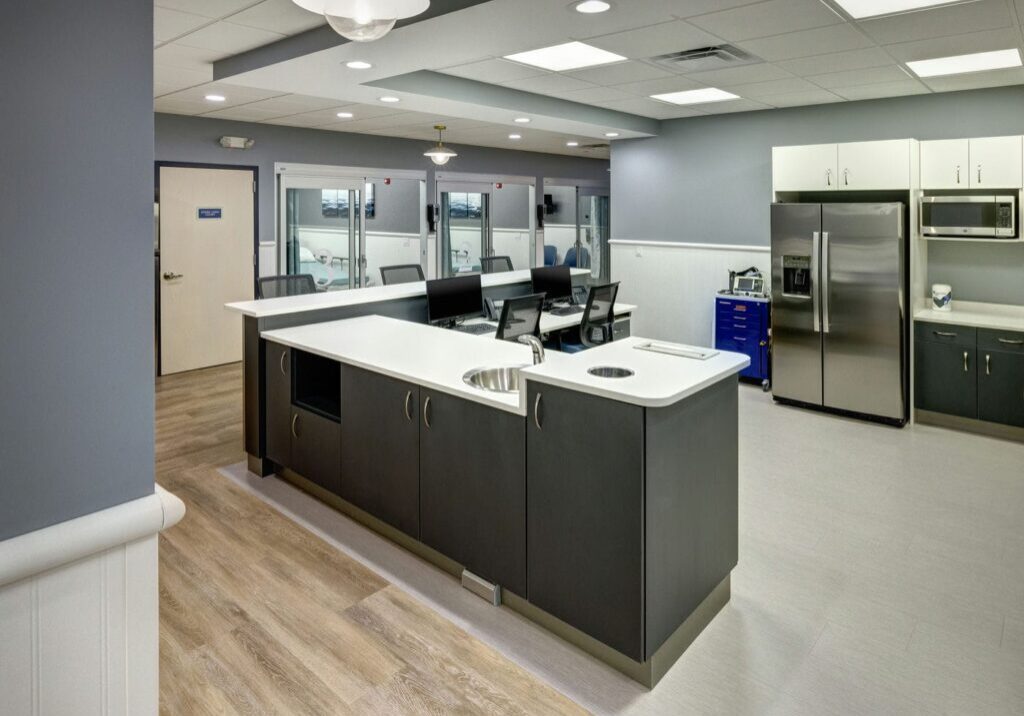
Outpatient surgical procedures are typically provided at office-based surgery suites (OBSs), ambulatory surgery centers (ASCs), and hospital outpatient departments (HOPDs). Although all three facilities specialize in outpatient surgeries, they each offer unique settings in hand with a combination of different healthcare services that fall under different regulatory requirements.
As a result, they each have unique facility design needs. Let’s break down the design differences among these outpatient surgery facilities to help define the unique requirements for each.
Office Based Surgery Suites (OBS)
OBS suites offer a convenient facility option with shared space for both surgical procedures and the surgeon’s clinic/office. As a result, this is the most cost-effective solution if you are a surgeon who can operate out of one location. Patients requiring minor surgical procedures with limited post-operative care are treated in familiar surroundings and can recover comfortably with minimal observation before being released.
From a design standpoint, OBSs require the necessary medical equipment and supplies to safely perform minor surgeries. So, it’s important to consider the current electrical system’s ability to take on the increased load density and electrical distribution components required for surgery.
Other considerations include:
- Improving ergonomics for patients and staff
- Considering efficiency between office and surgical staff
- Introducing a continuous laminar flow system to improve infection control
- Using mounting systems to accommodate expansion and make spaces more flexible
Efficient use of space is critical as there is a balance of office and medical staff contributing to your facility traffic and workflow. Also, consideration for the number of rooms equipped with surgical equipment, and the use of flex space will help optimize revenue generation.
And when it comes to accreditation laws, OBSs fall under special ones with standards that include patient safety and facility cleanliness. Compliance with building codes and state regulations must all be included in effective facility design.
Ambulatory Surgery Centers (ASC)
Unlike OBSs, ASCs are standalone licensed facilities specifically designed for outpatient surgery. These facilities provide a wide range of surgeries and procedures requiring fully equipped operating rooms with specialized systems and equipment. However, the entire facility also requires specialty systems as part of the infrastructure such as:
- High performance HVAC systems
- Emergency and isolated power
- Piped medical gases
- Sterilization facilities
- Water treatment
- Call systems
Further controls and functional considerations that contribute to a sterile, efficient, and comfortable environment include:
- Ample space to accommodate equipment and patient movement
- Optimized workflow planning
- Controlled acoustics
- Natural light
- Plant life to reduce stress and nurture healing and wellness (biophilia)
- Incorporating the most durable and hygienic materials to reduce cleaning and maintenance costs
Regulations impacting ASCs include state Department of Health standards, FGI Guidelines for Design and Construction of Outpatient Facilities and the NFPA Life Safety Code.
Hospital Outpatient Departments (HOPD)
Finally, HOPDs are located in hospitals or medical centers providing same-day surgical services. When it comes to the types of patients treated in these facilities, HOPDs are similar to ASCs, handling minor and complex surgeries. The main difference between HOPDs and ASCs is that HOPDs have access to the hospital’s departments and services under the hospital’s license. As such, they don’t fall under the facility separation requirements like ASC’s.
HOPDs often share facility systems with other departments such as mechanical and electrical. Also, conversions from HOPDs to ASCs are becoming a common practice, offering you the opportunity to collect higher reimbursements for surgical procedures. Key considerations for HOPD designs or conversions include:
- Ensuring support spaces, shared functions, and administrative spaces are in proportion to the number of treatment spaces
- Modularity that makes it easy to change function without interfering with mechanical systems that impact the rest of the hospital
- Consistent access locations in walls and ceilings for systems such as HVAC ductwork, electrical conduit and wiring, and plumbing piping for easy scalability, repairs, and alterations
- Flexible designs that make it easier to scale neighboring departments up or down with easy to move, adaptable department boundaries
When designing an outpatient surgery facility, consider hiring a design company with deep healthcare expertise. Taking a comprehensive approach to design, architecture, and construction with an understanding of OBS, ASC, and HOPD differences ensures your designs align with your unique needs. It also ensures you remain compliant with specific licensing, regulatory, and accreditation requirements related to your facility.
Bring your outpatient surgery facility vision to life with Apex
Your outpatient surgery facility design and build project must align with patient needs while delivering optimum efficiency and compliance. Apex is your design build partner offering architecture, design and build capabilities using a proven integrated methodology, bringing your vision to reality using the highest standards possible.
